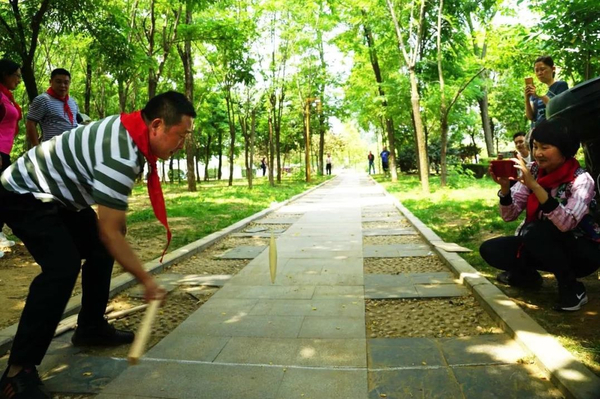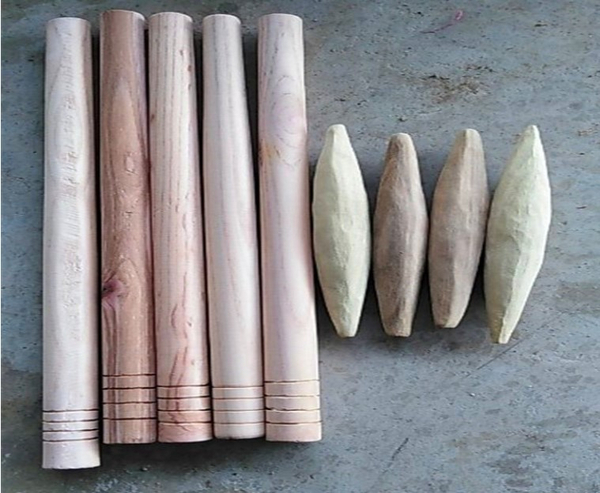
Da-ga (China)
- Name of sport (game): Da-ga
- Name in native language: 打尜、打嘎
- Place of practice (continent, state, nation):
China
- History:
The history of da-ga is not well known. Some say it was invented 1000 years ago (Tang Dynasty).
- Description:
Da-ga is a bit like modern baseball. Some people call it “grandfather” of baseball. It has different names around the world:
Lippa (Italy), Billarda (Spain), Pandolo (Slovenia), Klipa, Kiczka or Sztekiel (Poland) etc.The Playing Field
For regulation games, the length of the field should be 50 meters long. The important lines are the base line and the sidelines. The overall surface is compacted or paved but not necessarily completely flat. You can also play on grassy surface, but then you may need a moveable firm base to place the Ga-ga for hitting.The Equipment
• Base - Originally it was a stony flat surface but for modern competitions they use a firm flat rectangle made from metal materials. It is placed on the baseline which is the line in the narrower part of the field.
• Bat/Stick– is a 55 cm long piece of wood with rounded ends.
• Ga – it is made from wood. On both of the edges it is shaped into a cone.
• Face protection – a protective shield for the face, which is usually made of plastic. All defence players should use this protection.
• Gloves – for protection of the defence players hands;
• Uniform – players of each team have their own uniform, although it is not required.
Teams
The game is played between two competing teams. Each team plays with three players.
In a game of Da-ga there is also a referee. He must not interfere, unless a team has something to object or the play is too slow. In that case he solves the conflict on the base of the rules or simply warns the players to speed up the game. There are even yellow and red cards to punish bad words or insulting other team players.
Playing the Game
Goal of the game
The goal of the game is to score as much points as possible by hitting the “ga” towards the end of the playfield. The team that has more points at the end of the game is the winner.
Game segments
The game is played in rounds. In each round, both teams take part in attacking and defending. The toss of a coin before the start decides which team will start first on the offensive side and which in the defence.
Only the attacking team has player active on the playing field while the other team-mates are watching. On the other side, the whole defending team is active on the field. When the first player completes his turn, he is replaced with the next player from the attacking team. When all the offensive players have finished, the teams switch places – the defending team becomes the offensive team and the offensive team goes to the defence. The game then continues until all of the new offensive team's players have finished playing. Then it’s the end of the first round.
In the second round everything repeats. The only difference is that the first attacking team now starts in defence.
Flow of the Game
Every active player completes his active role if not prematurely struck out, in the following phases of the game:
Phase One – Active game of the first player
The first step is to toss the ga into the game or “service”. The defence team spreads out in the wide area of the field. No defence player, however, can be closer than 12-stick lengths from the base. The active player places himself maximum 1 stick far from the base. He holds the ga in his hand. When the game starts, the active player:
- hits the base with the stick,
- then he shouts “Da-ga, Da-ga zero” so everyone on the field can hear,
- with his hand, he throws the ga straight up into the air and he hits it with the stick into the playing filed,
- if the ga doesn’t land in the field, he has two more attempts.
Phase Two – Catching the ga
The defending players tries to catch the ga in the air. If they succeed the active player has ended his turn. Otherwise the ga is stopped on the ground by defending players, or it stops somewhere in the field by itself.
Phase Three – Targeting the Base
From the point where the ga was stopped, one of the defence players tries to throw the ga to strike the base. The active player can defend the base only with the stick. If the ga anyway hits the base, the active player is struck out and he ends his turn. Otherwise the game continues.
Phase Four – Striking the ga
The active player that has not been struck out continues the game. The active player places the ga near the base (1 stick in length). The defence team players take their positions in the playing field and no closer than 12-stick lengths from the base. When everyone is ready, the active player places himself near the ga. With one hit, on the edge, the ga lifts in the air and with the second hit he sends the ga towards the end line. If the defending player doesn’t catch the ga in the air, the active player repeats the last step two more times.
Phase Five – Counting Points
The points are counted only if the active player has finished everything without the ga being caught in the air by the defending players.
The attacking team measures, by eye, the distance between the base and the ga. One of the players than loudly says the distance in the unit of stick.
If the defending team agrees with the distance the players scored as much points as the distance was. Otherwise they measure it using the stick from the ga to the base. If the attacking team said a bigger number then the measured, they lost all the points. If they said a correct or a smaller number, the points are doubled.
Second game and subsequent games of the first active player.
Other players that follow the first, play in the same way as mentioned before.
When everyone completes their turns, and the teams are changed, the second round starts. The rules are the same and each player has to attack once more. The end of the second round is the end of the game. The team with more points wins.
In the case of a draw, each of team members has one chance to hit the ga from the base. The winning team is the one that strikes the ga further out than the other team. If both teams strike the ga beyond the end line, the ga striking continues until one team wins by striking the ga further out into the confines of the playing field.Concluding the game
At a tournament, the game is normally played in two groups. The first and the second team of each group passes to the finals where the first team plays with the second one of the other group. The winners then play the final game for the 1st place at the tournament. - Current status:
Practiced
- Gallery:

